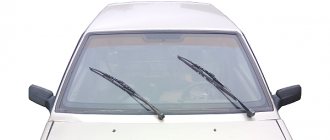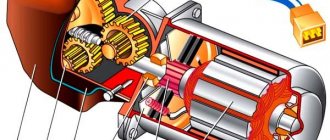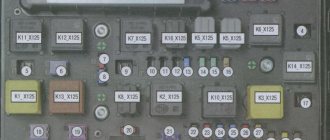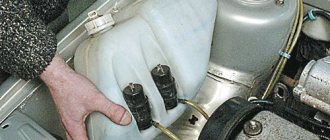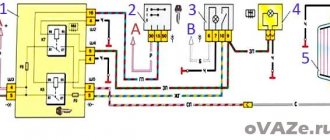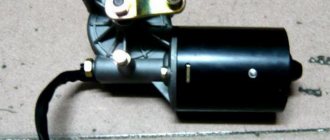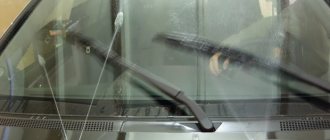The VAZ 2114 windshield washer fuse is necessary to protect the electrical wiring from ignition when an increased load or short circuit occurs. To determine where the VAZ 2114 windshield washer fuse is located, you should find out what type of mounting block is installed on the car. Depending on the year of manufacture of the VAZ 2114, the design of the fuse box is different.
Additional Information
How to change the cigarette lighter fuse
Here is an example of how to correctly change the cigarette lighter fuse on a BMW X3 E53.
Russian translation of errors from the dashboard
RELEASE PARKINGBRAKE-Release the parking brake CHECK BRAKE FLUID-Check the brake fluid level STOP! ENGINE OILPRESS-Stop! Low engine oil pressure COOLANT TEMPERATURE-Coolant temperature* BOOTLID OPEN-Trunk open DOOR OPEN-Door open CHECK BRAKE LIGHTS-Check brake lights CHECK LOWBEAM LIGHTS-Check low beams CHECK TAIL LIGHTS-Check tail lights CHECK PARK LIGHTS-Check side light CHECK FRONT FOGLAMP-Check front light. fog lights CHEK REAR FOGLAMP CHECK NUMPLATE LIGHT CHECK TRAILER LIGHTS CHECK HIGHBEAM LIGHT CHECK REVERSE LIGHTS CHECK REVERSE LIGHTS TRANS. FAILSAFE PROG-Automatic transmission emergency program CHECK BRAKE LININGS-Check the brake pads WASHER FLUID LOW-Add water to the washer reservoir CHECK ENGINE OIL LEV-Check the engine oil level IGNITION KEY BATTERY-Replace the ignition key battery CHECK COOLANT LEVEL-Check the coolant level LIGHTS ON ?-Is the light on? CHECK STEERING FLUID LEV - Check the hydraulic steering oil
Causes of washer malfunction
If the windshield washer does not work, it will not be difficult for an experienced driver to identify the cause of such a malfunction, and even a beginner, after familiarizing himself with the main failures in the cleaning system, will be able to eliminate them on his own.
Mechanical problems
The most important reason, as mentioned above, may be the lack of washer fluid; in this case, you just need to top it up. If it is present, but does not splash in the winter, then perhaps it is simply frozen. In this case, the problem can be solved in one of two ways:
- warming up the engine;
- bringing the car into a warm garage.
After the liquid has thawed, the system will begin to operate as usual, but it is better to drain the water from the tank after this and replace it with an “anti-freeze” one.
If you are interested in information about how to make an antifreeze with your own hands, read the material from our specialist.
Other significant mechanical reasons why the windshield washer does not spray include the following factors.
- Clogged injectors. Their exit can be blocked by various debris: rust, dirt or small particles. To check the correctness of the guess, you need to stop the supply of working fluid to the nozzles; if this is the case, then the supply of “anti-freeze” will be normal. The solution to this problem lies in replacing the nozzles.
- Disconnecting the hose. It may simply fly off while driving on bumpy roads, and then the fluid supply will continue, but the headlight and windshield washer nozzle will remain dry. Sometimes this happens in cars in which the connecting fittings are located on the hood, then when it is closed, the hoses are squeezed. In any case, the deformed or torn tube must be replaced and returned to its place.
Electrical faults
After checking the fluid level, the cleanliness of the injectors and the hose leading to them, it may turn out that all this has nothing to do with it, then the issue is for the following reasons:
- Fuse blown. You will need to find the safety block and check the insert; it can be found using the attached diagram, which is usually printed on the cover or in the car’s operating instructions. After checking, if this is indeed the reason, then you need to replace the damaged part
- Motor failure. To establish the accuracy of your guess, you should connect a multimeter to the motor terminals and check the voltage when you turn on the washer. If the voltage indicator is normal, but the motor remains inoperative, then the problem lies with it. You can determine which motor has failed by elimination, by moving the pump terminals from the windshield to its rear counterpart.
- Washer switch malfunction. It is usually located on the steering wheel. If, after checking the voltage, it is missing, and replacing the motor with a new unit did not help, then it turns out that the windshield washer switch or relay is not working. Only an experienced auto electrician can accurately diagnose a breakdown.
- Oxidation of pump terminals. During operation, they can not only oxidize, but also completely fall off, which is why the motor stops pumping liquid. To return everything to working condition, you need to clean the oxidized terminals or replace them with new ones.
Useful tips
Although the car windshield washer system is quite simple, breakdowns that occur for one reason or another cannot be ruled out.
It is important to understand that failure of individual system components occurs both in summer and winter. To avoid premature washer failures at any time of the year, you should always adhere to two rules:
To avoid premature washer failures at any time of the year, you should always adhere to two rules:
- use a special liquid;
- do not overload the washer motor;
If we consider the issue of liquid separately, in the summer you can use both summer and winter washer fluid. At the same time, it is a mistake to believe that liquid is better for winter. On the one hand, this option is noticeably more expensive, but this does not mean that this liquid is better.
In other words, it is not advisable to pour anti-freeze in the summer. Winter liquids do not have any special properties compared to summer liquids in terms of the quality of cleaning the glass itself. Their main difference is that summer washers freeze in cold weather, while winter washers do not.
It turns out that if in summer you can use any liquid, in winter you need to pour what is suitable for the season (winter washer fluid). Also, the winter washer fluid used must have the required properties (taking into account temperature fluctuations in a particular region).
For example, anti-freeze down to -5 degrees will not be suitable if severe frosts are expected. You have to purchase compounds down to -10, -15, -25 degrees, etc.
At the same time, the price of the washer fluid directly depends on frost resistance. In fact, anti-freeze -5 will cost more than summer liquid, but noticeably cheaper than an analogue designed for use at temperatures of -20, -25, etc. These are the most relevant recommendations for winter.
As for summer, you should not try to save money and fill the washer with regular tap water. At a minimum, the filters will become dirty. In the worst case scenario, clogged washer nozzles will have to be replaced. In some situations, it may even be necessary to replace the washer motor, which cannot cope with heavy loads.
By the way, about loads. If the fluid is poorly pumped through the system, the filters and nozzles are dirty, the tubes are crushed or broken, the fluid level in the tank is constantly low, then the motor experiences increased loads. In such conditions, it is more difficult for the system to pump liquid.
Also, if the driver turns on the washer for a long time (10 seconds or more), the motor and the entire pump mechanism also wear out actively. As practice shows, when paired with high-quality brushes, it is enough to apply liquid to the glass in short pulses of 2-3 seconds. If the liquid is not supplied in the required volume, it is necessary to diagnose and clean all components of the windshield washer system.
Let us also add that for cars that are operated in severe frost conditions, it is not superfluous to have heated washer fluid, heated wipers, heated washer nozzles, etc.
Such solutions make it possible to heat the washer fluid reservoir, prevent freezing of the liquid in the nozzles themselves, etc. The main thing is not to apply heated liquid onto glass that is too cold. The reason is that glass can crack as a result of a sharp temperature change.
Block under the hood
It is located next to the washer fluid reservoir, under the protective cover.
Description
Option 1
| F1 | 10A Emission control system |
| F2 | 15A Emission control system |
| F3 | 15A Emission control system |
| F4 | 10A Emission control system |
| F5 | 30A Diesel combustion products filter evaporator, Glow plug control system |
| F6 | 3A Anti-lock braking system. Maintaining sustainability. Ignition |
| F7 | 7.5A Powertrain control module |
| F8 | 20A Cooling Fan |
| F9 | 30A Left windshield wiper |
| F10 | 30A Right windshield wiper |
| F11 | 10A Air conditioning compressor clutch |
| F12 | 20A Glow plug for the evaporator of the diesel combustion product filter |
| F13 | Reserve |
| F14 | 30A Emission control system - ignition |
| F15 | Not used |
| F16 | Not used |
| F17 | Not used |
| F18 | 40A Anti-lock brakes, stability control pump |
| F19 | 30A Starter Solenoid |
| F20 | 60A Glow plugs |
| F21 | 60A Ignition relay 3 |
| F22 | Reserve |
| F22 | Reserve |
| F23 | Reserve |
| F24 | 7.5A High Pressure Fuel Pump |
| F25 | Reserve |
| F26 | Reserve |
| F27 | Reserve |
| F28 | Reserve |
| F29 | Reserve |
| F30 | 40A Cooling fan 1 |
| F31 | 40A Fan 2 cooling systems |
| F32 | 60A Electric motors (two) windshield wipers |
| F33 | 20A Start-stop auxiliary water pump |
| F34 | Reserve |
| F35 | 15A Power supply for powertrain control system |
| F36 | 15A NOXI 2 sensor |
| F37 | 7.5A Volume control valve |
| F38 | 7.5A Mass air flow sensor |
| F39 | 15A Diesel Pump Fuel Evaporator |
| Relay | |
| R1 | Ignition |
| R2 | Starter |
| R3 | Rear window wiper |
| R4 | Not used |
| R5 | cooling Fan |
| R6 | Windshield wiper - on and off |
| R7 | Windshield wiper - low and high speed |
| R8 | Not used |
| R9 | Not used |
| R10 | Air conditioning compressor clutch |
| R11 | Evaporator system fuel glow plug |
| R12 | High pressure fuel pump |
| R13 | All Wheel Drive Pump |
| R14 | Econetic system |
| R15 | Cooling fans: high speed and low speed |
| R16 | Emission control system |
| R17 | Powertrain Control Module |
| R18 | Cooling fan - high speed |
Option 2
| F1 | 5A Switching off the radio sound |
| F2 | Reserve |
| F3 | Reserve |
| F4 | Reserve |
| F5 | Reserve |
| F6 | 15A Nitrogen oxide sensor |
| F7 | 15A Particulate Sensor |
| F8 | 20A High Speed Cooling Fan |
| F9 | Reserve |
| F10 | Reserve |
| F11 | Reserve |
| F12 | Reserve |
| F13 | Reserve |
| F14 | Reserve |
| F15 | Reserve |
| F16 | Reserve |
| F17 | Reserve |
| F18 | 40A Cooling Fan 2 |
| F19 | 40/60A cooling fan |
| F20 | 40A Emission control system |
| F21 | 40A Glow plug 2 |
| F22 | 40A Glow plug 1 |
| F23 | 10A Air conditioning compressor clutch |
| F24 | Reserve |
| F25 | 15A Right headlights with high intensity discharge lamps |
| F26 | 15A Left headlights with high intensity discharge lamps |
| F27 | Reserve |
| F28 | 5A Heating element for positive crankcase ventilation valve |
| F29 | 7.5/15A Coolant pump |
| F30 | 40/60A Powertrain Control Module Relay |
| F31 | 20A Run-start relay 2 |
| F32 | 20A Fuel fired auxiliary heater |
| F33 | Reserve |
| F34 | Reserve |
| F35 | 20A Powertrain Control Module |
| F36 | 20A Power wire 5 car |
| F37 | 15A Tank with reagent. Exhaust gas recirculation valve |
| F38 | 10A High speed cooling fan. Air conditioning compressor clutch. Low speed cooling fan. High and low speed cooling fan relay. Relay coils R1, R5, R10, and R15 of the engine electrical junction box |
| F39 | Glow plug control system |
| Relay | |
| R1 | High speed cooling fan |
| R2 | Not used |
| R3 | Rear window wiper |
| R4 | Air suspension module |
| R5 | Cooling Fan |
| R6 | Not used |
| R7 | Left headlights with high intensity discharge lamps |
| R8 | Right headlights with high intensity discharge lamps |
| R9 | Starter |
| R10 | Air conditioning compressor clutch |
| R11 | Not used |
| R12 | Not used |
| R13 | Emission control system catalyst |
| R14 | Not used |
| R15 | Low speed cooling fan |
| R16 | Not used |
| R17 | Not used |
| R18 | Powertrain Control Module |
Additional relay and fuse box
It is located behind the glove compartment at the feet of the front passenger. To access, unfortunately, you will have to remove the glove box. The fuses for the electric fans of the cooling system and the engine control relay (injection system) are located here.
Scheme
Purpose
- Additional relay (turns on the right electric fan through an additional resistor at low rotation speed);
- Fuse (50A) protecting the power circuits of the additional relay and the right electric fan relay;
- Fuse for the fuel pump (fuel pump) (15A), protecting the power circuits of the electric fuel pump relay;
- Fuse (15A) protecting the constant power supply circuit of the controller;
- Right electric fan relay;
- Left electric fan relay;
- Electric fuel pump relay;
- Main relay;
- Fuse (50A) protecting the left electric fan circuits;
- Fuse (15A) protecting power circuits switched on by the main relay;
- Controller
Washer fuse location
In different cars, the fuse blocks and the fuses themselves are located in different orders; there is no single standard so that the block is, for example, on the right and there is a certain order of which fuse is responsible for what. Find out the location of the block and a specific fuse, for example, when replacing the cigarette lighter fuse. Therefore, we will consider for specific brands and models of cars in the photo.
On a VW Jetta 6 (Volkswagen Jetta 6), the washer fuse is located in the engine compartment, to the right of the engine. Location of the washer fuse in the block of the VAZ 2110. The block itself is located in the passenger compartment on the driver's side. The fuse responsible for the operation of the washer is number 9 (second from the right from the top).
Location of washer fuse Wolksvagen Passat B7
Do-it-yourself modification and replacement of wipers
Which wipers are better is up to the car owner to decide. Those installed on the VAZ 2110, as well as on the UAZ, do their job well from the factory, but it can be modified with washers from other companies that are of higher quality. Many people are attracted to frameless brushes - this is a good option. They are compact in size and equipped with a special leash mechanism. True, they do not look very attractive on the VAZ 2110, since the fastener to the standard washer arm turns out to be massive. Therefore they need improvement.
Frameless car washers
To perform a replacement or modification, you must perform the following steps:
- First you need to disconnect the negative terminal on the battery.
- Then you need to tilt the mount towards you and remove the brush.
- If there is a decorative trim, it must be removed.
- By unscrewing the bolt, you can remove the old brush.
- Before replacing parts, be sure to check the dimensions of the new washer with the old one. It is advisable that the new one does not exceed the size of the old one by more than 2 cm.
- Installation of the new kit is carried out in the reverse order.
Sorry, there are no surveys available at this time. https://www.youtube.com/watch?v=Pg9cb6Fr3JI
How is it arranged?
The washer system consists of:
- tank (located on the right in the photo);
- pump (motor);
- water supply hoses;
- nozzles that directly supply water to the windshield of the car.
Set of nozzles Nozzles are installed so that the jet is directed to the middle part of the glass. A pump (motor) is necessary for direct water supply. It should be noted that in some modifications, water is supplied simultaneously to the headlights and also to the rear window.
Pump motor
The pump itself is a small motor consisting of:
- oil seal;
- brushes;
- impeller.
This part is significantly different for different modifications. But there is only one purpose - to supply washer fluid. In most cases, the malfunction lies either in the tank itself or in the injectors. Depending on the modification of the car, these elements need to be replaced or simply repaired. But if the motor breaks down, it will most likely need to be replaced.
Where is?
Everyone knows the situation when the water in the windshield washer reservoir runs out, but in order to top it up, you need to at least have an idea where it is. And this is a problem for some, because when we open the hood, we see several tanks at once, and it’s hard to figure out where exactly the one we need is located.
The tank we need is usually located to the right of the battery, and next to it is the block that contains the fuse that is responsible for the windshield washer system.
Video “Improving front window washing”
This video tells you not only where the windshield washer system is located, but also how to make it work better.
Cars have special equipment for travel during bad weather associated with precipitation. The windshield of the VAZ 2107 is cleaned of water using movable brushes, and in case of contamination, the washer is activated. This device sprays a special liquid, it works simultaneously with the windshield wipers and removes dirt.
The equipment thus provides the necessary visibility for the driver and passengers. This device includes the following elements:
- Liquid reservoir.
- A pump that runs from the on-board network.
- Nozzles that blow a water jet onto the windshield of a car.
- Tubes connecting the tank to the actuators.
At the end of the summer season, the water in the system is replaced with non-freezing liquid, which will allow the system to be used in winter.
conclusions
If the rear or windshield washer fails, any problem can be quickly resolved, the main thing is to find the cause of the malfunction. In case of problems with nozzles and their complete replacement, it is better to choose these fan-type parts; they wet the glass better. Problems with the integrity or partial deformation of connecting tubes are best solved by connecting new cords. To avoid the listed problems with the washer system, you should use non-chlorinated water in warm weather, and “anti-freeze” water in cold weather.
Sources:
https://autostuk.ru/gde-naxoditsya-predoxranitel-na-omyvatel-lobovogo-stekla.html https://avtozam.com/help/omyivatel-lobovogo-stekla/ https://voditeliauto.ru/poleznaya-informaciya /to-i-remont/omyvatel-lobovogo-stekla.html https://russia-avto.ru/remont/pochemu-ne-rabotaet/ne-rabotaet-omyvatel-stekla-na-vaz https://motorsguide.ru /system/omyvatel-lobovogo-stekla
Electrical
Problems with electrical systems are rare. You can fix them yourself, but if in doubt, contact an experienced mechanic.
- The first place among the problems is the failure of the fuse. It’s easy to fix the problem - re-read the car’s operating instructions and use the symbols to find the required fuse and replace it with a new one.
- Another reason is that the washer motor does not work. The reason is oxidation of the terminals or their falling off. To eliminate the malfunction, you need to clean the contacts and reconnect the components if necessary.
- It also happens that the washer switch on the steering wheel does not work. You can check this using a multimeter. Connect the device to the motor terminals and check the voltage. If it is in order, but the mechanism does not work, most likely the switch is to blame. But a problem in the electrical wiring or lack of closure of the device relay cannot be ruled out. If it doesn’t work after replacing it yourself, you can’t do it without an experienced technician.
Main problems
All existing faults with the front washer can be divided into two main types, which have their own sub-problems, so to speak. We invite you to familiarize yourself with them in the table.
| Fault type | Failure options |
| Mechanical problems | The washer fluid reservoir is empty |
| The hose fell off the pump | |
| The injectors are clogged | |
| Electrical faults | Fuse burned out |
| The clamps have oxidized | |
| The switch is broken |
But each of these faults deserves a more detailed consideration.
Mechanical breakdowns
It is with mechanical washer malfunctions that owners of the VAZ 2110 most often encounter. This is compared with the regularity of electrical problems.
- The washer fluid tank is empty. Inexperienced drivers often start blaming a faulty pump, although in practice they simply forget to check the antifreeze level in the tank. Hence the unjustified costs for the services of service stations. Don’t forget to check the fluid level, and in winter, be sure to drain the regular washer fluid and fill it with anti-freeze in its place. Ordinary water at subzero temperatures will turn into ice, and therefore will not be able to take part in cleaning the windshield. If you still forget to drain and the water freezes, warm up the car for a while so that the ice melts, then drain and fill with a suitable liquid.
- The hose fell off. Anti-freeze is supplied from the tank to the windshield using a pump and special hoses. If these same hoses begin to jump out of their places, the liquid will not be able to flow to the nozzles. As a result, the washer does not function. Try to secure them better. And if they are worn out, simply replace the old hoses with new ones. If the mounting is normal, water may still not flow to the nozzles. In this case, check whether the hoses are pinched.
- The injectors are clogged. The anti-freeze agent, supplied by a pump and passing through hoses, then exits onto the windshield using nozzles. These are the same small devices from which streams of water come. If they are dirty, disconnect the hoses from the injectors and check their condition. Often the problem lies in the jets. They are easy to clean, but in some situations they may need to be replaced.
Article on the topic: Manufacturing of acoustic shelves and podiums for the VAZ 2114
Pump and reservoir
Electrical breakdowns
Although mechanical failures are more common, electrical problems should not be forgotten.
- The fuse has blown. If, when you turn on the device for cleaning the windshield, the pump does not show signs of functioning, there is a fairly high probability that the cause is a failed fuse. Check its condition. If the device really burns out, you can simply replace it with a new one.
- The switch does not work. If the pump stops working, but the fuse is intact, then the problem may be a faulty steering column switch. To check this, do a little system testing. But for this you will need an assistant. Turn on the ignition and ask a friend to turn on the washer. In this case, go to the pump yourself and check for voltage in it. If there is voltage but no functionality, you will have to change the motor, that is, the pump. If there is no voltage, then the culprit is a switch, relay or wiring. Check everything. Replace what is necessary.
- The clamps have oxidized. Be sure to check the condition of the pump terminals. It’s not uncommon for wiring to oxidize due to moisture and literally fall apart over time. If this happens to your washer, try to properly replace the damaged wiring.
Windshield washer device
The process of troubleshooting a windshield washer begins with studying the design of the device and finding the cause of the problem.
- tank - is a special container that contains working fluid (usually it is located in the engine compartment, equipped with a filler neck and a cap);
- washer fluid level sensor - not present on all cars, but required if a glass washer and optics are combined;
- the pump is an important element due to which the working fluid is supplied at the required pressure;
- nozzles – necessary for spraying the washer composition, installed in pairs (the nozzle can be fan or jet);
Why is the windshield washer not working?
The causes of windshield washer malfunction can be divided into:
physical;
electric.
The physical reasons are based on the freezing of the liquid poured into the washer system. It is incorrect to believe that water freezes when the ambient temperature is below zero degrees Celsius.
Water can freeze even at positive ambient temperatures. While the car is moving, the thin tubes of the washer system and the nozzle are blown by air currents. At high humidity, due to physical processes, the tube is cooled, blown by high-speed air flows. If the ambient temperature is slightly positive, the temperature of the liquid in the tube (nozzle) may drop to minus values.
There is a lot of counterfeit on the Russian market. It’s a good idea to check the quality of the washer fluid (washer fluid) by placing it in a small plastic bottle in the freezer. The temperature in the freezer is approximately minus 18 degrees Celsius. There are times when the washer temperature is “-30 degrees”, and the liquid freezes in the freezer.
Washer failure can occur when water gets into the windshield nozzle (sprinkler). It is located at a positive angle to the horizon, therefore, if non-freezing liquid leaves it (this is possible due to insufficient tightness of the tubes and wear of the pump), rainwater and condensation after fog enter the free cavity. A microscopic drop is enough to block the washer fluid supply channel when frozen, and the system will be inoperable.
Video - how to defrost ice in the washer reservoir (some useful tips):
Physical malfunctions include loss of tightness of the membrane in the pump. Most electric washer pumps are of the membrane type. When the membrane wears out or is ruptured by frozen water, the pump drive remains operational, the pump “buzzes,” but does not pump liquid.
Another physical malfunction is damage to the integrity of the washer tubes.
Electrical faults include:
pump electric drive malfunction;
damage to electrical wiring;
failure of the fuses servicing the pump (often when the pump freezes);
Malfunction of the electronic body control unit.
Prevention measures
In order to avoid sudden problems with the operation of the windshield washer system, you must:
- promptly refill the washer reservoir with antifreeze liquid and remove water from the system;
- check the quality of the antifreeze in the freezer; it is better to buy liquid at a gas station;
- remove the chip from the pump and inject silicone grease into the contact area, it pushes water out of the contact area, preventing corrosion;
- if the tubes crack, replace them with serviceable ones, you can take silicone tubes from an IV (sold at any pharmacy);
- When operating a vehicle at temperatures below minus 25 degrees Celsius, it is recommended to install heated injectors.
Read the article about how to decarbonize oil scraper rings without disassembling the engine, and in what cases this has to be done.
Do I need to charge a new battery immediately after purchasing it in a store?
Video - searching for the cause of a windshield washer malfunction on a VAZ 2112:
Fuse and relay box in the passenger compartment
It is located on the left side at the passenger's feet, closed with a protective cover.
Option 1
Scheme
Description
| F1 | AP01 / Additional socket |
| F2 | Front seat heater |
| F3 | Audio system |
| F4 | Air conditioner |
| F5 | Electronic body control unit |
| F6 | Door lock |
| F7 | Turn signal right side |
| F8 | Turn signal left side |
| F9 | Stop |
| F10 | Headlight washers |
| F11 | Air conditioner |
| F12 | Electronic body control unit |
| F13 | Electronic body control unit |
| F14 | Ignition: S/W |
| F15 | Rear fog light |
| F16 | Airbag (AIR BAG) |
| F17 | Front washer |
| F18 | Front door lock |
| F19 | Additional socket |
| F20 | Transmission control unit |
| F21 | Engine |
| F22 | Low beam |
| F23 | Window lifter |
| F24 | Exterior mirror heater |
| F25 | Dashboard |
| F26 | Ignition 1 |
| F27 | AIR BAG |
| F28 | Folding mirror* |
| F29 | Cigarette lighter fuse |
| F30 | Passenger side power window |
| F31 | Driver's side power window |
| F32 | Watch |
| R1 | Air Conditioner Relay Component/Fixed Auxiliary Electrical Outlet |
| R2 | Ignition: ON/START |
Description for pre-restyling
Block under the hood
General photo - diagram
Description of fuses
| F1 | Not used |
| F2 | Not used |
| F3 (25) | Chains: fuel pump and ignition coils; main relay K5 of the engine management system |
| F4 (15) | Air conditioning compressor electromagnetic clutch circuit |
| F5 (40) | Power circuits: low speed cooling fan short circuit relay |
| F6 (60) | Circuits protected by fuses F9, F10, F28, F29, F30, F31, F32, F36 of mounting block 1 in the passenger compartment |
| F7 (60) | Circuits protected by fuses F13, F14, F15, F16, F17, F18, F19, F20, F24, F26, F27, F37, F38, F39 of the mounting block in the passenger compartment |
| F8 (60) | Circuits protected by fuses F1, F2, F3, F4, F5, F11, F12 of the mounting block in the passenger compartment |
| F9 (25) | Circuits under voltage in position S and A of the ignition key |
| F10 (80) | Power circuits of the interior electric heater relay |
| F11 (50) and F12 (25) | ABS control unit circuits |
Relay designation
- K1 - High speed cooling fan relay
- K2 - Air conditioner relay
- Short circuit - Low speed cooling fan relay
- K4 - Fuel pump and ignition coil relay
- K5 - Main relay of the engine control system
- K6 - Not used
- K7 - Fog lamp relay. If it is not there, then the PTFs are not installed.
- K8 - Heater fan relay
Other versions of this block.
Heated rear window does not work
In this case, you can download the full description here.
Block in the cabin
Located at the end of the dashboard on the driver's side behind the cover.
Scheme
Decoding
| F1 (20) | Chains: windshield wiper; tailgate glass heating relay coils |
| F2 (5) | Circuits: instrument cluster power supply; relay windings K4 of the fuel pump and ignition coils; the power supply to the engine control system ECU is from the ignition switch; |
| F3 (10) | Brake light circuits |
| F4 (10) | Chains: turn signal lamps; engine management system diagnostic connector (pin 1); immobilizer coils; switching block |
| F5 (5) | Rear gearbox electromagnetic clutch control circuit |
| F6 | Reserve |
| F7 | Reserve |
| F8 | Reserve |
| F9 (10) | Left headlight low beam circuit |
| F10 (10) | Right headlight low beam circuit |
| F11 (10) | Circuits: high beam lamps of the left headlight; high beam headlight indicator in the instrument cluster |
| F12 (10) | Right headlight high beam lamp circuit |
| F13 (30) | Rear door power window circuits |
| F14 (30) | Front door power window circuits |
| F15 (10) | ABS control unit circuit |
| F16 (15) | Driver and front passenger seat heating circuits |
| F17 (15) | Audio circuits |
| F18 (10) | Circuits: left side headlight lamps; left rear side light bulbs |
| F19 (10) | Circuits: side light bulbs of the right headlight; side light bulbs for the right rear light; license plate lamps; glove compartment lamps; Illumination of the instrument cluster and controls on the instrument panel, console and floor tunnel lining |
| F20 (7.5) | Rear fog lamp circuit |
| F21 (5) | Exterior mirror heating element circuits |
| F22 | Reserve |
| F23 | Reserve |
| F24 (5) | Power steering control circuit |
| F26 (5) | Airbag control unit circuit |
| F27 (20) | Chains: parking sensors; reversing lamps; windshield and tailgate glass washer |
| F28 (15) | Circuits: interior lamps; trunk lamps; backlight lamps for the head unit of sound reproduction |
| F29 (15) | Circuits: intermittent windshield wiper; turn signal switch; hazard switch; central locking control; buzzer; engine management system diagnostic connector |
| F30 (20) | Central lock chains |
| F31 (15) | Fog light circuit |
| F32 (30) | Heated tailgate glass relay power circuit |
| F33 | Reserve |
| F34 (15) | Rear gearbox electromagnetic clutch circuit |
| F35 | Reserve |
| F36 (30) | Heater fan relay K8 power circuit |
| F37 (5) | Electric drive circuits for exterior rear view mirrors |
| F38 (15) | Cigarette lighter renault duster; power supply to the head unit for sound reproduction from the ignition switch |
| F39 (10) | HVAC Motor Relay |
Separately, under the anti-theft device, along the dashboard beam, there can be a relay for an additional interior heater (1067 - 1068), and under the instrument panel a rear window heating relay (235).
How to repair?
The glass washer system is not complicated, and the faults are almost the same in most cases, so once you become familiar with them, you can carry out the repairs yourself.
Mechanical reasons
| Elimination method | |
| The fluid in the washer reservoir is frozen | It is necessary to drive the car into a room where the temperature is above zero, close the hood, start and warm up the engine thoroughly. Fill with new antifreeze fluid. |
| The hose came off | Put the hose back in place. |
| The motor shaft turned. You can hear the washer motor making noise, but no fluid comes out. | Replace the mechanism. |
| The hose through which water flows to the nozzles is pinched | Replace or straighten the hose. |
| The injectors are clogged | Clean or replace. |
